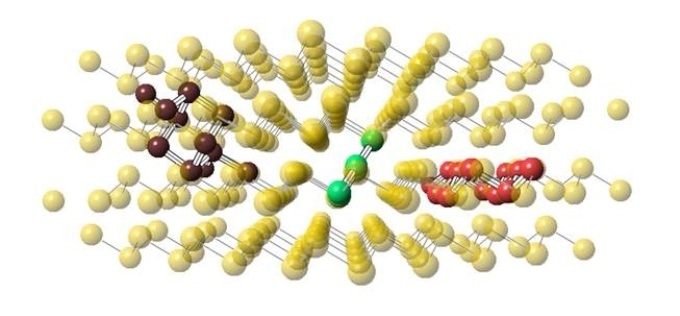Mar 14 2017
 This recovered bismuth sample has a rhombohedral structure and contains liquid structural motifs after deep melting at high pressures. The surprising structural memory effect in the molten state is responsible for the unexpected change from magnetic repulsion to magnetic attraction in bismuth. CREDIT: Image courtesy of Yu Shu and Guoyin Shen.
This recovered bismuth sample has a rhombohedral structure and contains liquid structural motifs after deep melting at high pressures. The surprising structural memory effect in the molten state is responsible for the unexpected change from magnetic repulsion to magnetic attraction in bismuth. CREDIT: Image courtesy of Yu Shu and Guoyin Shen.
A research team including Guoyin Shen and Yoshio Kono from Carnegie has performed a new study that involves using high temperature and pressure to uncover a type of “structural memory” in bismuth samples. This discovery has great electrical engineering potential.
For researchers, bismuth has always been a historically interesting element because many significant findings in the field of metal physics were made when bismuth was studied. The findings include significant observations related to the effect of magnetic fields on electrical conductivity.
Bismuth includes many phases, of which the chemical phase is a unique configuration of molecules forming a substance. Boiling of water into steam and freezing of water into ice are instances of the ways in which alterations in external conditions induce a transition from one phase to the other.
However, for materials scientists and physicists, the application of extreme temperatures and pressures can produce a broad range of other phases. For instance, bismuth goes through a range of phase transitions under increasing temperature and pressure conditions, which includes eight different kinds of solid phases discovered thus far.
Earlier research on bismuth indicates that pressure-induced structural changes were not maintained upon reduction in pressure. However, the researchers adopted a pathway of successive temperature and pressure conditions to develop a type of bismuth comprising of a “structural memory” of an earlier phase.
The research team included lead author Yu Shu and his collaborators Dongli Yu, Wentao Hu, Bo Xu, Julong He, and Zhongyuan Liu from the Yanshan University, as well as Yanbin Wang from the University of Chicago.
Upon applying a pressure equal to 14,000 - 24,000 times the normal atmospheric pressure, that is, 1.4 - 2.4 GPa, at a temperature of nearly 1800 °F, that is, 1250 K, and transforming bismuth into a liquid state and then slowly cooling it again to a solid state, the solid “remembers” specific structural motifs of its liquid predecessor.
The high-pressure liquid becomes more structurally disordered when the heat is applied, taking on what we call a ‘deep liquid’ state, certain structural characteristics of which remain even when the bismuth is cooled back to solid. This is the first time such an effect has been seen in an elemental metal.
Guoyin Shen, Carnegie
Interestingly, the “memory” is similar to a shift from being repelled to being attracted by a magnetic field. The researchers are convinced that a similar shift can be induced in physical characteristics of other similar elements such as cerium, plutonium, antimony, and others.